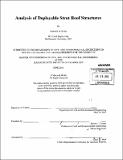| dc.contributor.advisor | Jerome J. Connor. | en_US |
| dc.contributor.author | Wolfe, Maxwell H. (Maxwell Henry) | en_US |
| dc.contributor.other | Massachusetts Institute of Technology. Department of Civil and Environmental Engineering. | en_US |
| dc.date.accessioned | 2013-12-06T20:46:45Z | |
| dc.date.available | 2013-12-06T20:46:45Z | |
| dc.date.issued | 2013 | en_US |
| dc.identifier.uri | http://hdl.handle.net/1721.1/82827 | |
| dc.description | Thesis (M. Eng.)--Massachusetts Institute of Technology, Department of Civil and Environmental Engineering, 2013. | en_US |
| dc.description | Cataloged from PDF version of thesis. "June 2013." | en_US |
| dc.description | Includes bibliographical references (pages 55-56). | en_US |
| dc.description.abstract | Deployable structures are structures that can change shape from a compact to an expanded form. Thus, their advantage over conventional structures is adaptability, whether in the sense of adapting to changing environmental conditions or being adapted for repeated transportation and deployment. These features make deployable structure highly desirable for a wide range of applications in the aerospace, military, and architectural fields. However, these structures are often only designed as small scale "products", rather than structures requiring full analysis and design procedures. Much work has focused on the various geometries of the deployment mechanisms without considering practical engineering aspects. If deployable structures are to be designed on the scale of large civil structures, a proper understanding of the flow of forces through the structure is required. This thesis begins with a brief discussion of deployable structures in general before moving on to geometric constraints of strut-type deployable structures. Then, it details a preliminary analysis of one class of deployable structures, known as angulated element structures. These structures are designed to be operable roofs spanning over sports facilities. During deployment, the center of the structure opens or closes to accommodate changes in weather conditions. Building on the geometry established in other work, the relationships between the basic geometric parameters of angulated element rings and their structural characteristics are determined. SAP2000 analysis results are used to make specific design recommendations. The feasibility of using this type of structure for an operable long span roof is confirmed. | en_US |
| dc.description.statementofresponsibility | by Maxwell H. Wolfe. | en_US |
| dc.format.extent | 59 pages | en_US |
| dc.language.iso | eng | en_US |
| dc.publisher | Massachusetts Institute of Technology | en_US |
| dc.rights | M.I.T. theses are protected by
copyright. They may be viewed from this source for any purpose, but
reproduction or distribution in any format is prohibited without written
permission. See provided URL for inquiries about permission. | en_US |
| dc.rights.uri | http://dspace.mit.edu/handle/1721.1/7582 | en_US |
| dc.subject | Civil and Environmental Engineering. | en_US |
| dc.title | Analysis of deployable strut roof structures | en_US |
| dc.type | Thesis | en_US |
| dc.description.degree | M.Eng. | en_US |
| dc.contributor.department | Massachusetts Institute of Technology. Department of Civil and Environmental Engineering | |
| dc.identifier.oclc | 863155378 | en_US |
